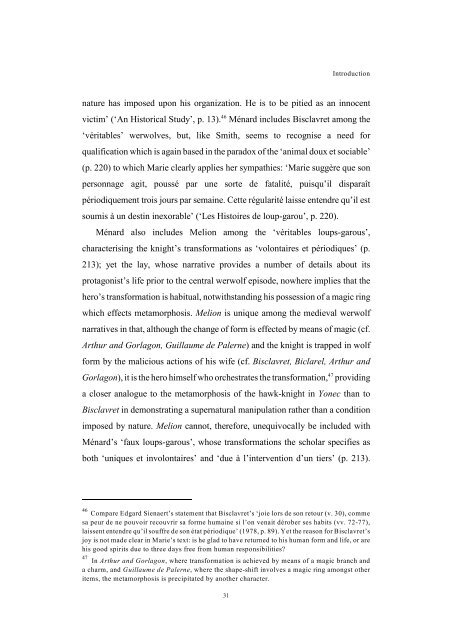Melion and Biclarel - University of Liverpool
Melion and Biclarel - University of Liverpool
Melion and Biclarel - University of Liverpool
Create successful ePaper yourself
Turn your PDF publications into a flip-book with our unique Google optimized e-Paper software.
Introduction<br />
nature has imposed upon his organization. He is to be pitied as an innocent<br />
46<br />
victim’ (‘An Historical Study’, p. 13). Ménard includes Bisclavret among the<br />
‘véritables’ werwolves, but, like Smith, seems to recognise a need for<br />
qualification which is again based in the paradox <strong>of</strong> the ‘animal doux et sociable’<br />
(p. 220) to which Marie clearly applies her sympathies: ‘Marie suggère que son<br />
personnage agit, poussé par une sorte de fatalité, puisqu’il disparaît<br />
périodiquement trois jours par semaine. Cette régularité laisse entendre qu’il est<br />
soumis à un destin inexorable’ (‘Les Histoires de loup-garou’, p. 220).<br />
Ménard also includes <strong>Melion</strong> among the ‘véritables loups-garous’,<br />
characterising the knight’s transformations as ‘volontaires et périodiques’ (p.<br />
213); yet the lay, whose narrative provides a number <strong>of</strong> details about its<br />
protagonist’s life prior to the central werwolf episode, nowhere implies that the<br />
hero’s transformation is habitual, notwithst<strong>and</strong>ing his possession <strong>of</strong> a magic ring<br />
which effects metamorphosis. <strong>Melion</strong> is unique among the medieval werwolf<br />
narratives in that, although the change <strong>of</strong> form is effected by means <strong>of</strong> magic (cf.<br />
Arthur <strong>and</strong> Gorlagon, Guillaume de Palerne) <strong>and</strong> the knight is trapped in wolf<br />
form by the malicious actions <strong>of</strong> his wife (cf. Bisclavret, <strong>Biclarel</strong>, Arthur <strong>and</strong><br />
47<br />
Gorlagon), it is the hero himself who orchestrates the transformation, providing<br />
a closer analogue to the metamorphosis <strong>of</strong> the hawk-knight in Yonec than to<br />
Bisclavret in demonstrating a supernatural manipulation rather than a condition<br />
imposed by nature. <strong>Melion</strong> cannot, therefore, unequivocally be included with<br />
Ménard’s ‘faux loups-garous’, whose transformations the scholar specifies as<br />
both ‘uniques et involontaires’ <strong>and</strong> ‘due à l’intervention d’un tiers’ (p. 213).<br />
46<br />
Compare Edgard Sienaert’s statement that Bisclavret’s ‘joie lors de son retour (v. 30), comme<br />
sa peur de ne pouvoir recouvrir sa forme humaine si l’on venait dérober ses habits (vv. 72-77),<br />
laissent entendre qu’il souffre de son état périodique’ (1978, p. 89). Yet the reason for Bisclavret’s<br />
joy is not made clear in Marie’s text: is he glad to have returned to his human form <strong>and</strong> life, or are<br />
his good spirits due to three days free from human responsibilities?<br />
47<br />
In Arthur <strong>and</strong> Gorlagon, where transformation is achieved by means <strong>of</strong> a magic branch <strong>and</strong><br />
a charm, <strong>and</strong> Guillaume de Palerne, where the shape-shift involves a magic ring amongst other<br />
items, the metamorphosis is precipitated by another character.<br />
31
















